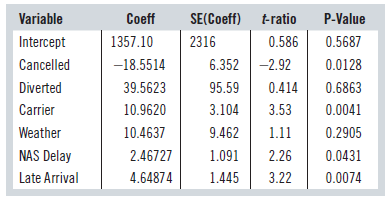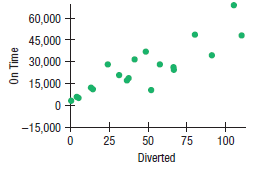Airlines strive to be on time, in part because customers can refer to government-published statistics to select
Question:
Airlines strive to be on time, in part because customers can refer to government-published statistics to select f lights that are most often on time. We have data for 19 airlines for March 2006 reporting the following variables:
On Time (number of on-time arrivals)
Cancelled (number of cancelled flights)
Diverted (number of diverted flights)
Carrier (number of delays due to the carrier)
Weather (number of delays due to weather)
NAS Delay (delays due to the National Airspace System [traffic control])
Late Arrival (number of delays due to late arrival of equipment or crew)
Here’s a regression model:
Dependent variable is: On Time
R-squared = 93.9% R-squared (adjusted) = 90.8%
s = 5176 with 19 - 7 = 12 degrees of freedom


a) Interpret the coefficient of Diverted.
Here’s a scatterplot of On Time vs. Diverted and another regression. Note that Diverted is the response variable in this second regression.

Dependent variable is: Diverted
R-squared = 85.6% R-squared (adjusted) = 80.0%
s = 15.02 with 19 - 6 = 13 degrees of freedom

b) It seems from the scatterplot that Diverted would be a good predictor of On Time, but that seems not to be the case. Why do you think the coefficient of Diverted isn’t significant in the first regression?
c) How does the second regression explain this apparent contradiction?
d) Find the value of the variance inflation factor statistic for Diverted in the first regression.
Step by Step Answer:

Business Statistics
ISBN: 9780133899122
3rd Canadian Edition
Authors: Norean D. Sharpe, Richard D. De Veaux, Paul F. Velleman, David Wright





